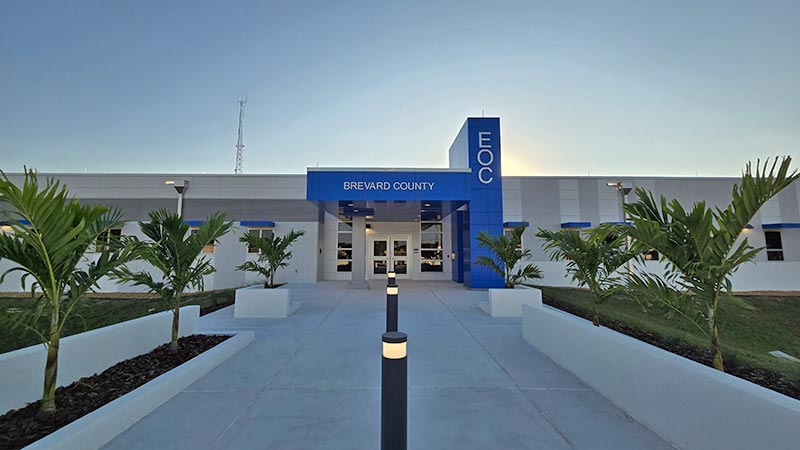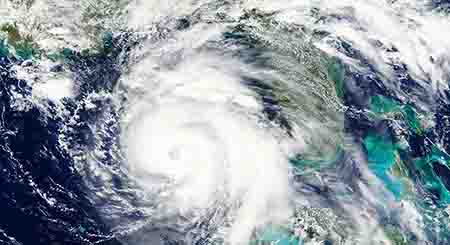Brevard County Emergency Management Response
In the event of an emergency, we will conduct emergency operations to save lives and property by positioning emergency equipment and supplies; evacuating potential victims; providing food, water, shelter, and medical care to those in need; and restoring critical public service.
The onset of an emergency creates a need for time-sensitive actions to save lives and property, as well as for action to begin stabilizing the situation so that the jurisdiction can regroup. Such response actions include notifying Emergency Management personnel of the crises, warning and evacuating or sheltering the population if possible, keeping the population informed, rescuing individuals and providing medical treatment, maintaining the rule of law, assessing damage, addressing mitigation issues that arise from response activities, and even requesting help from outside the jurisdiction.

Brevard County Emergency Operations Center
The Brevard County Emergency Operations Center (EOC), under the supervision of Brevard County Emergency Management (BCEM), at the direction of the Brevard County Emergency Coordination Group (ECG), and in conjunction with county departments, agency liaisons and municipalities, will act as the primary direction and control facility during times of disasters and other warranted emergency situations for the assignment of resources as well as the coordinated response and recovery efforts.
Authority for emergency response activities by local and state officials and agencies is set forth in Florida Statute Chapter 252, and the Governor’s Executive Order #80-29. These documents provide local governmental jurisdictions with the authority to compel the evacuation of citizens within the legal boundaries, and to declare a Local State of Emergency.

Emergency Operations
On a daily basis, Brevard County Emergency Management staff performs disaster planning, training, and exercise functions. During emergency activations, Emergency Management is responsible for managing the operations of the EOC. EOC staff is responsible for the overall coordination of Brevard County incident management and resources during disaster response and recovery operations.
The EOC will serve as Brevard County’s primary seat of government during all emergency disasters and the designated meeting place for the Emergency Coordination Group.
The primary purpose of the county EOC is to perform four core functions:
- Collect, analyze, and share information
- Coordinate response and recovery efforts
- Communicate clearly to all responsible parties, in a unified voice
- Coordinate and track resource requests

Emergency Coordination Group
Members of the Emergency Coordination Group provide (ECG) input for policy decisions on priorities and objectives based on situational needs and the Comprehensive Emergency Management Plan. They participate by providing information to be considered in the decision-making process and for the orderly development of policies during all phases of preparation, response, and recovery of an emergency situation. The Policy Group members also provide input regarding resource coordination and support to the on-scene command from the Emergency Operations Center to ensure consistency. The members of the ECG are:
- Chair of the Board of County Commissioners, or designee
- County Manager, or designee
- Public Safety Director, or designee
- Emergency Management Director, or designee
- Fire Chief, or designee
- County Attorney, or designee
- Sheriff, or designee
- Superintendent of Brevard Public Schools, or designee
- Brevard County Health Department Director, or designee
- Representative of Space Coast Public Management Association
The primary role of this group is to facilitate the alignment of countywide emergency protective actions through the sharing of information. Each member maintains individual authority and does not direct the actions of nor supersede the authority of any other member.

Local State of Emergency
The Declaration of a Local State of Emergency provides for the waiver of normal procedures and formalities otherwise required of political subdivisions by law pertaining to:
- Performance of public work and taking whatever action is necessary to assure health, safety, and welfare of the community;
- Entering into contracts;
- Incurring obligations;
- Employment of permanent and temporary workers;
- Utilization of volunteer workers;
- Rental equipment;
- Acquisition and distribution, with or without compensation, of supplies, materials, facilities; and
- Appropriate and expenditure of public funds.
Emergency Operations Center Activation Levels
Brevard County Emergency Management is responsible for recommending the level of activation, securing the necessary approvals, initiating report-for-duty calls to the Emergency Operations Center, and notifying local and state agencies/organizations.
Based on the size and scope of the incident, the Chairperson of the Brevard County Board of County Commissioners and/or the Emergency Management Director may activate the Comprehensive Emergency Management Plan (CEMP), request mobilization of some or all Emergency Support Functions (ESFs), and/or activate the County EOC.
There are three levels of EOC activation in Brevard County:
(3) Monitoring
The monitoring phase of the EOC is the normal day-to-day operations of the EOC. This phase is also designated as a Level 3 activation. During this phase the EOC operates under normal operations.
(2) Partial Activation
The partial activation phase is a heightened level of alert within the EOC. This phase is designated as a Level 2 activation and occurs when an incident is of a smaller size or when an event regularly occurs within Brevard County’s jurisdiction. Response by Emergency Management personnel will be needed, and selected Emergency Support Functions may be called to the EOC to assist the EM Director and EM staff in managing the situation.
(1) Full Activation
The full activation phase is the highest EOC activation level and is designated as a Level 1 activation. This phase occurs when an incident requires the full participation of Emergency Management personnel as well as all required Emergency Support Functions to include county departments as well as internal and external agencies.
Emergency Support Functions and Liaisons
Agency responsibilities have been functionally aligned according to the Emergency Support Function (ESF) concept. Under this concept, developed by FEMA in 1992, types of assistance that are most likely needed in the aftermath of a major disaster are functionally grouped into ESFs. Each ESF is headed by a primary agency which is selected based on its authorities, resources, and capabilities.
- ESF #1 - Transportation
- ESF #1 provides overall management, coordination and prioritization, of government (Federal, State or local) and private transportation resources to meet the requirements of disaster assistance organizations responding to a Brevard County event. Evacuation transportation is also made available in the pre- and post-event time periods to individuals identified through the county’s Special Needs Registry or otherwise requiring evacuation assistance at the time of an event.
- ESF #2 - Communications
- ESF #2 plans, coordinates, and assists in communications support to county and local emergency response elements. This ESF also coordinates the communications assets (both equipment and services) available from State agencies, voluntary groups, County agencies, the telecommunications industry, Federal government agencies, and the U.S. military. ESF #2 is the focal point of all communications support activity at the county level before, during and after activation of the County Emergency Operations Center (EOC).
- ESF #3 - Public Works
- ESF# 3 provides technical advice and services utilizing the public works personnel, equipment and resources of the designated primary and support agencies. ESF #3 provides these services to the areas of Brevard County impacted by an event, as well as assisting affected municipalities within the county with similar services when necessary. ESF #3 is primarily responsible for public works assistance and services in all unincorporated areas of the county, as well as for roadways and components of the infrastructure owned or operated by the county within its municipalities.
- ESF #4 – Firefighting
- ESF #4 addresses control and coordination of fire suppression and prevention actions undertaken at the time of a major emergency or disaster threatening or impacting Brevard County or several of its municipalities. This ESF addresses firefighting activities conducted when other county ESFs are also activated to respond to and recovery from an emergency or disaster event. This ESF does not address the normal day-to-day firefighting operations by Brevard County or any of its municipalities, but only those conducted during events requiring multi-jurisdictional operations and warranting the activation of the CEMP and the EOC.
- ESF #5 - Information and Planning
- ESF #5 addresses those procedures and actions that will be taken within the EOC to facilitate information flow within and to outside locations and facilities, as well as to support strategic planning actions by the EOC Policy Group during county-wide response and recovery operations.
- ESF #6 – Mass Care
- ESF #6 addresses the management and coordination of emergency services necessary for the care and support of individuals displaced by a disaster event in Brevard County. The scope of this ESF encompasses sheltering of individuals evacuating threatened areas, as well as providing care for disaster victims remaining in damaged areas experiencing prolonged disruption to utilities and other fundamental community services.
- ESF #7 – Resource Support
- ESF #7 provides coordination and/or provision of logistical and resource support for emergency response and recovery operations to other county ESFs and impacted municipalities within the county during the implementation of the CEMP for an emergency or disaster situation affecting Brevard County.
- ESF #8 – Health and Medical Services
- ESF #8 is responsible for the coordination of health and medical services necessary for the public affected by a disaster, as well as emergency workers engaged in response and recovery activities within the county for that event. The health and medical services to be provided include medical and mental health services for disaster victims and emergency workers. Environmental Health Services will coordinate services related to detecting and correcting environmental dangers to aid in the reduction of environmental health risks in the aftermath of a disaster.
- ESF #9 – Search and Rescue
- ESF #9 provides the coordination for search and rescue operations during emergencies and disaster occurring within Brevard County.
- ESF #10 – Hazardous Materials
- ESF #10 involves response to hazardous materials incidents that result in damages and disruptions caused by or resulting from other disaster events, whether natural or man-made in origin. ESF #10 would also be utilized to coordinate the response to a major hazardous materials release occurring separately from other hazard events, whether caused by an accident or an intentional criminal act.
- ESF #11 – Food and Water
- ESF #11 identifies, secures and arranges for the acquisition, transportation and distribution of food, ice and water following a disaster. Food, water and ice supplies will be made available for disaster victims and emergency workers in affected areas, at facilities activated for the response and recovery effort, and at on-scene locations, as indicated. Food and beverages obtained and distributed by ESF #11 will be prepared and served by ESF #6 Mass Care.
- ESF #12 – Utilities
- ESF #12 coordinates response and recovery efforts by Brevard County to address emergency power, water and wastewater, and energy needs before, during and after a disaster.
- ESF #13 – Military Support
- Due to the uniqueness of military support, ESF #13 coordinates the use of military resources (Department of Defense and Florida National Guard (FLNG)) to support the needs of local governments, voluntary organizations, and other ESFs in performance of their emergency support role during response, recovery and assistance missions in a major or catastrophic emergency.
- ESF #14 – Public Information
- ESF #14 provides for the coordination of emergency instructions and public information emanating from Brevard County at the time of a disaster. This ESF defines the procedures and concepts that will be used by the County for developing and disseminating information and instructions to the public regarding emergency situations, as well as to assist and support the print, electronic and broadcast media in obtaining information regarding the event.
- ESF #15 – Volunteers and Donations
- ESF #15 encompasses soliciting selected goods or services to be donated; coordinating the receipt, sorting and storing of donated goods, whether solicited or unsolicited; assigning volunteers to response and recovery operations; and distributing donated goods to support agencies and directly to disaster victims.
- ESF #16 – Law Enforcement
- ESF #16 includes traffic and crowd control, maintaining civil order, looting prevention, building and shelter security, search and rescue, evacuation support and other services needed to provide for the safety and security of the general public and the protection of property. The scope of ESF 16 further includes enforcement of any emergency ordinances or temporary regulations imposed due to the event or its impacts. ESF #16 will also undertake to ensure the security of emergency workers, as well as facilities and locations activated for response and recovery efforts.
- ESF #17 – Animal Services
- ESF #17 defines the policies, procedures and responsibilities for coordination of operations to assist the citizens of Brevard County, local law enforcement and volunteer organizations to protect domestic animals, livestock, and pets affected by disaster, and to provide for control of wildlife displaced by the impacts of the event. ESF #17 provides for emergency medical care, evacuation, rescue, temporary confinement, shelter, identification for return to the owner for domestic animals and pets. ESF #17 also serves to protect citizens from the hazards caused by displaced, threatening or infected animals during and after a disaster, including the diagnosis, prevention, and control of animal-borne disease of public health significance.
- ESF #18 – Business and Industry
- ESF #18 defines the policies, procedures and responsibilities for coordination of local actions that will provide immediate and short-term assistance for the needs of business, industry, and economic stabilization. ESF #18 grants BCEM the ability to provide guidance to and coordination of issues within the business community during all hazards and all phases of emergency management.
- ESF #19 – Damage Assessment
- ESF #19 is responsible for the development of initial estimates of the impact of a disaster event, as well as the detailed damage estimates of public and private structures and components of the County’s infrastructure after a damaging emergency.